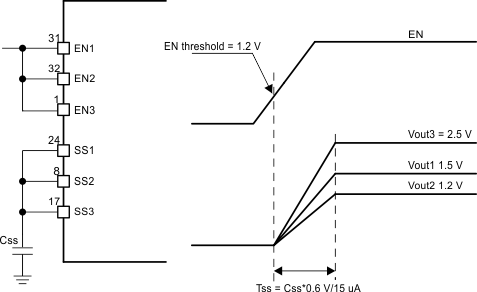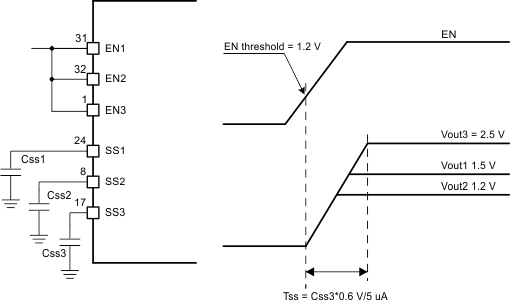SLVSCN0C june 2014 – may 2023 TPS65263
PRODUCTION DATA
- 1
- 1 Features
- 2 Applications
- 3 Description
- 4 Revision History
- 5 Device Comparison Table
- 6 Pin Configuration and Functions
- 7 Specifications
-
8 Detailed Description
- 8.1 Overview
- 8.2 Functional Block Diagram
- 8.3
Feature Description
- 8.3.1 Adjusting the Output Voltage
- 8.3.2 Enable and Adjusting UVLO
- 8.3.3 Soft-Start Time
- 8.3.4 Power-Up Sequencing
- 8.3.5 V7V Low Dropout Regulator and Bootstrap
- 8.3.6 Out-of-Phase Operation
- 8.3.7 Output Overvoltage Protection (OVP)
- 8.3.8 Pulse Skipping Mode (PSM)
- 8.3.9 Slope Compensation
- 8.3.10 Overcurrent Protection
- 8.3.11 Power Good
- 8.3.12 Thermal Shutdown
- 8.4 Device Functional Modes
- 8.5
Register Maps
- 8.5.1 Register Description
- 8.5.2 VOUT1_SEL: Vout1 Voltage Selection Register (offset = 0x00H)
- 8.5.3 VOUT2_SEL: Vout2 Voltage Selection Register (offset = 0x01H)
- 8.5.4 VOUT3_SEL: Vout3 Voltage Selection Register (offset = 0x02H)
- 8.5.5 VOUT1_COM: Buck1 Command Register (offset = 0x03H)
- 8.5.6 VOUT2_COM: Buck2 Command Register (offset = 0x04H)
- 8.5.7 VOUT3_COM: Buck3 Command Register (offset = 0x05H)
- 8.5.8 SYS_STATUS: System Status Register (offset = 0x06H)
- 9 Application and Implementation
- 10Device and Documentation Support
- 11Mechanical, Packaging, and Orderable Information
8.3.3 Soft-Start Time
The voltage on the respective SS pin controls the start-up of buck output. When the voltage on the SS pin is less than the internal 0.6-V reference, The TPS65263 regulates the internal feedback voltage to the voltage on the SS pin instead of 0.6 V. The SS pin can be used to program an external soft-start function or to allow output of buck to track another supply during start-up. The device has an internal pullup current source of 5 µA (typical) that charges an external soft-start capacitor to provide a linear ramping voltage at SS pin. The TPS65263 regulates the internal feedback voltage to the voltage on the SS pin, allowing VOUT to rise smoothly from 0V to its regulated voltage without inrush current. The soft-start time can be calculated approximately by Equation 4 .

Many of the common power supply sequencing methods can be implemented using the SSx and ENx pins. Figure 8-6 shows the method implementing ratiometric sequencing by connecting the SSx pins of three buck channels together. The regulator outputs ramp up and reach regulation at the same time. When calculating the soft-start time, the pullup current source must be tripled in Equation 4.
 Figure 8-6 Ratiometric Power-Up Using SSx Pins
Figure 8-6 Ratiometric Power-Up Using SSx PinsSimultaneous power supply sequencing can be implemented by connecting capacitor to SSx pin, shown in Figure 8-7. Using Equation 4 and Equation 5, the capacitors can be calculated.

 Figure 8-7 Simultaneous Startup Sequence Using SSx Pins
Figure 8-7 Simultaneous Startup Sequence Using SSx Pins